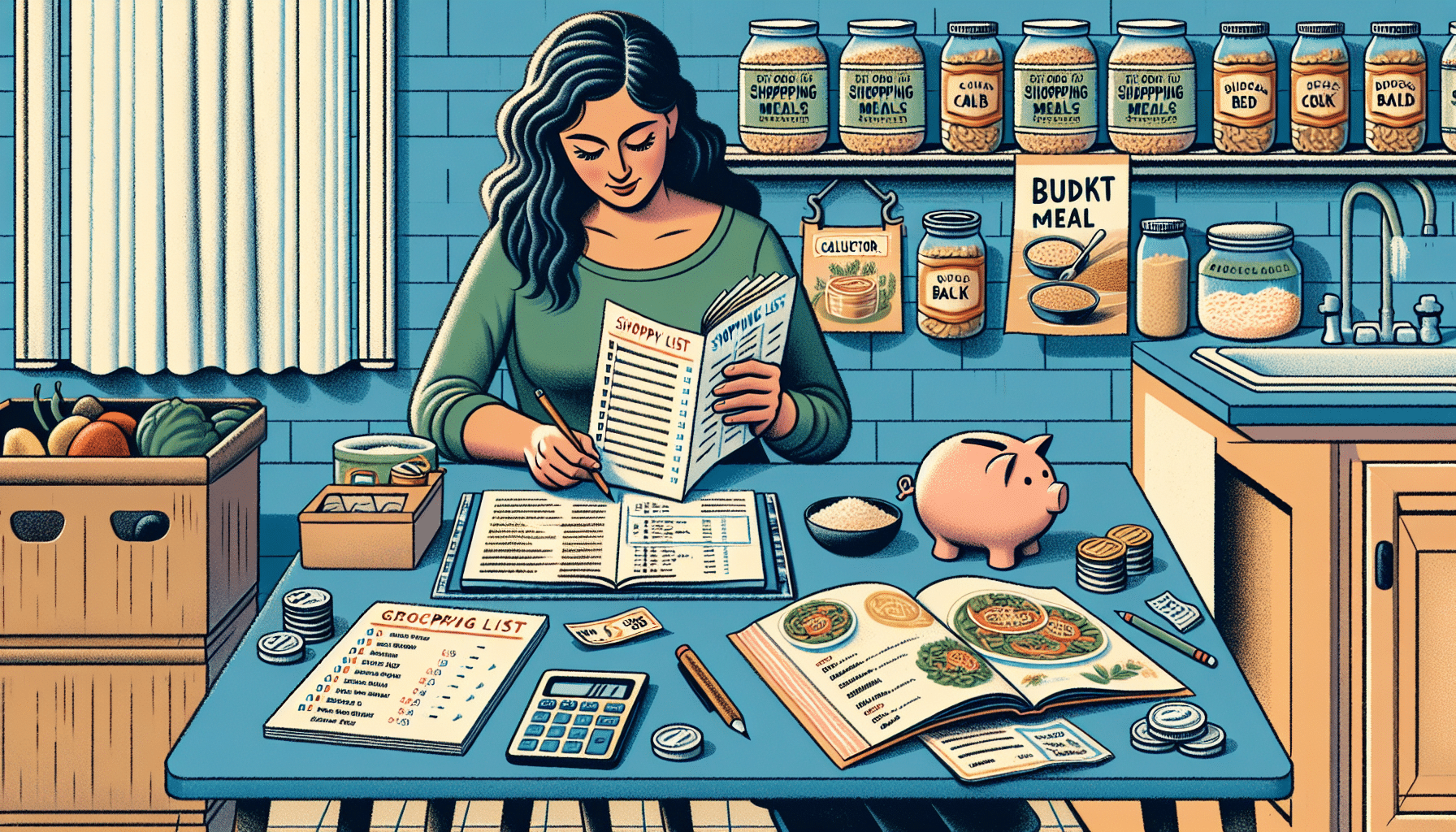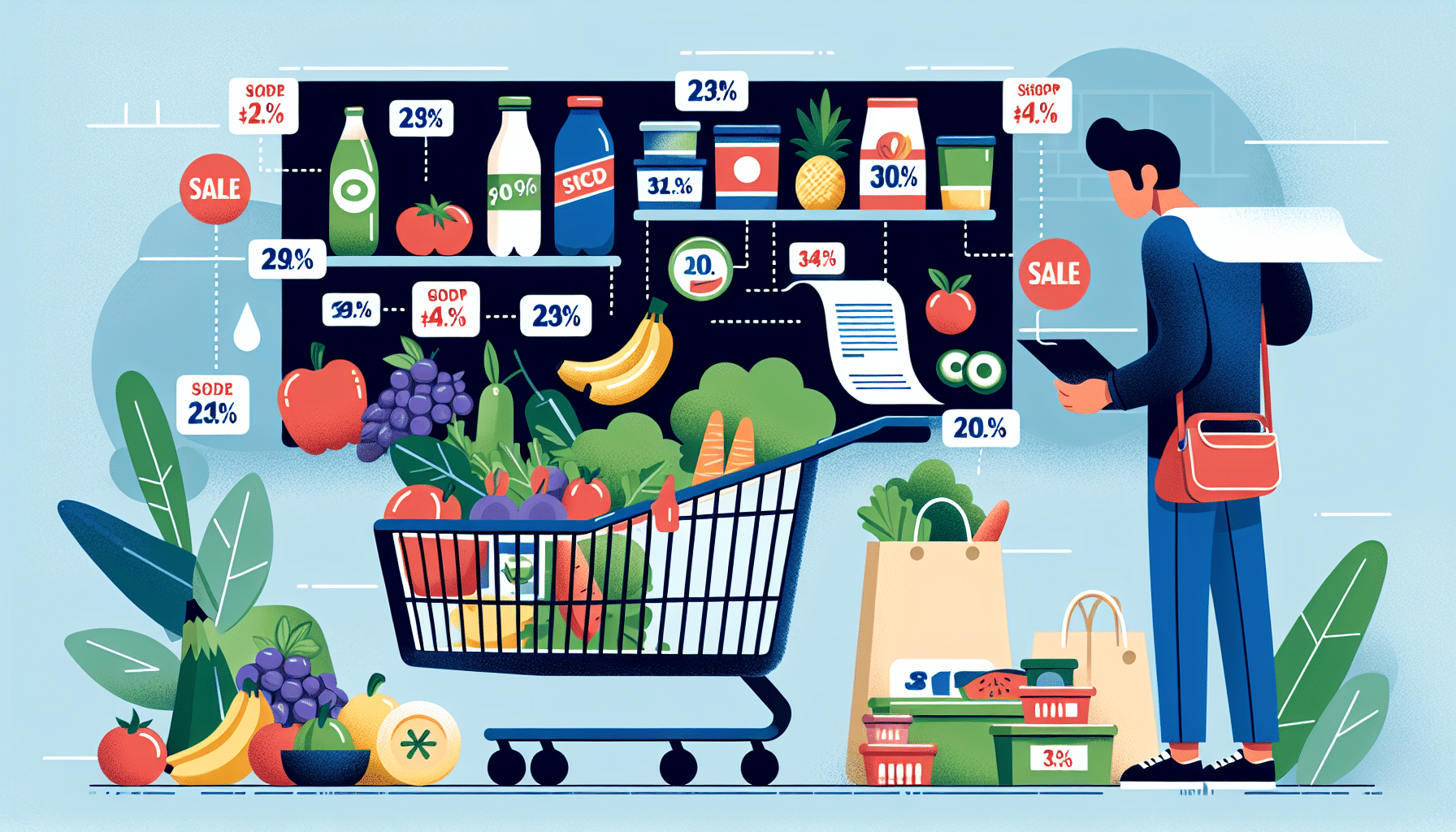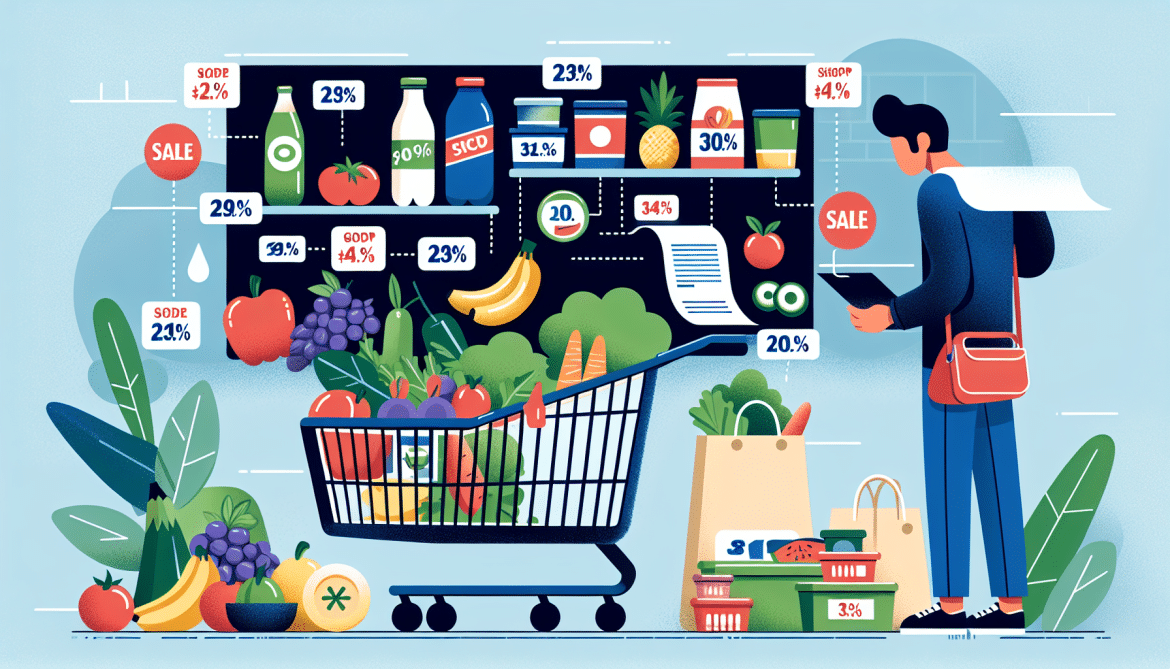Looking to make the most of your grocery budget? Look no further than a prepared shopping list. By taking the time to plan out your meals and create a list of necessary items, you can shop with intention and save money. Start by focusing on staple items that can be used in multiple dishes and consider using tools like apps and supermarket websites to find the best deals. Don't forget about generic or store brands, as they often offer a more affordable option. Shopping at multiple stores can also help you take advantage of the best prices on different items. And remember, avoiding prepared foods and stocking up on pantry staples and frozen foods can lead to significant savings. Don't forget to buy fresh produce, dairy products, and meat weekly, and keep certain ingredients on an "as-needed" list for occasional purchases. With a well-planned shopping list and a little bit of organization, you can maximize your grocery budget and make your meals go further.

This image is property of images.unsplash.com.
Building a Meal Plan
Meal planning is an essential part of building a successful grocery shopping strategy. By planning your meals ahead of time, you can not only save money but also ensure that you have a variety of balanced meals throughout the week.
Planning your meals
When creating a meal plan, take into consideration your dietary preferences, any dietary restrictions or allergies, and the number of people you are cooking for. Start by deciding on the number of meals you want to plan for, such as breakfast, lunch, and dinner.
Consider incorporating a mix of family favorites and new recipes to keep things interesting. Look for recipes that use similar ingredients to maximize your grocery budget. You can also create themed meal nights, such as Taco Tuesday or Meatless Monday, to simplify your meal planning process.
Creating a weekly meal plan
Once you have an idea of what meals you want to include, start mapping out your week. Use a planner or a spreadsheet to lay out the meals for each day and write down the corresponding recipes or meal ideas.
Take note of the ingredients required for each meal and keep track of any leftovers or ingredients you already have on hand. This will help you avoid buying unnecessary items and reduce food waste.
Choosing versatile ingredients
To make meal planning easier and more cost-effective, choose versatile ingredients that can be used in multiple dishes. For example, opt for ingredients like chicken breast, ground beef, or tofu, which can be used in various recipes throughout the week.
Also, consider using pantry staples like rice, pasta, and canned beans, as they can serve as a base for many different meals. By incorporating these versatile ingredients into your meal plan, you can create a variety of dishes without needing to buy an excessive amount of different ingredients.
Creating a Shopping List
Once you have your meal plan in place, it's time to create a shopping list. A well-organized and comprehensive shopping list is essential to ensure you get everything you need while avoiding impulse purchases.
Listing necessary items
Begin by listing all the ingredients you will need for your planned meals. Go through each recipe and carefully note down the specific quantities and types of ingredients required. This will help you stay organized and ensure you don't forget anything.
Including staple ingredients
In addition to the ingredients for your planned meals, make sure to include staple items on your shopping list. These are items that you use regularly and are essential for your kitchen. Examples of staple ingredients include salt, pepper, cooking oil, spices, and condiments.
By including these staple ingredients on your shopping list, you can avoid running out of essential items and make sure your kitchen is well-stocked.
Using shopping apps and websites
Take advantage of technology and use shopping apps and supermarket websites to simplify your shopping experience. Many grocery stores have their own apps or online platforms that allow you to create a digital shopping list, browse weekly specials, and even order groceries for delivery or pickup.
Using these tools can help you stay organized, compare prices, and discover deals that you may have missed otherwise.
Considering generic or store brands
When building your shopping list, consider opting for generic or store brands. These alternatives are often cheaper than name brands and can help you save money without compromising quality.
Generic products often have similar ingredients and nutritional value as their branded counterparts, so don't be afraid to give them a try. By including generic or store brands on your shopping list, you can stretch your budget further and still enjoy quality products.
Shopping Strategies
Having a plan when you step into the grocery store is key to staying on budget and making smart purchasing decisions. With a few shopping strategies in mind, you'll be able to navigate the aisles with ease and make the most of your trip.
Shopping at multiple stores
Consider shopping at more than one store to take advantage of the best prices on different items. Some stores may have lower prices on produce, while others may have better deals on meat or pantry staples. By diversifying your shopping destinations, you can maximize your savings.
Keep in mind that the savings from shopping at multiple stores should outweigh any additional transportation costs or time spent. Be strategic about the stores you choose and plan your shopping trips accordingly.
Comparing prices
Before adding an item to your cart, take a moment to compare prices. Look at similar products from different brands and check if there are any promotional offers or discounts available. This simple step can help you save money and ensure that you're getting the best value for your purchase.
Remember to consider the cost per unit or ounce when comparing prices, as larger pack sizes may be more cost-effective in the long run.
Avoiding prepared foods
Prepared foods, such as pre-cut fruits and vegetables, pre-packaged meals, and deli items, tend to be more expensive than their unprepared counterparts. While they may be convenient, they can quickly eat into your grocery budget.
Instead, opt for whole ingredients and take the time to prepare them yourself. Not only will this save you money, but it will also allow you to control the quality and freshness of your meals.
Stocking up on frozen foods and pantry staples
Take advantage of sales and stock up on frozen foods and pantry staples when possible. Frozen fruits, vegetables, and proteins are often cheaper than fresh options and can be just as nutritious. Additionally, canned goods, dried beans, and rice are shelf-stable items that you can buy in bulk to save money in the long run.
Having a well-stocked freezer and pantry ensures that you always have ingredients on hand to whip up a meal, even when you're running low on fresh produce.
Buying Fresh Items
While it's important to stock up on pantry staples, certain items should be purchased fresh on a regular basis to maintain quality and flavor.
Buying fresh fruits and vegetables
Fresh fruits and vegetables are essential for a balanced diet, and ideally, they should make up a significant portion of your meals. When shopping for produce, choose items that are in season, as they tend to be more affordable and taste better.
Inspect fruits and vegetables for freshness and choose ones that are firm, vibrant in color, and free of blemishes. Don't hesitate to ask store employees if you have any questions about specific produce items.
Purchasing dairy products and eggs
Dairy products, such as milk, yogurt, and cheese, and eggs are perishable items that should be bought fresh. Check the expiration dates on these products to ensure their freshness.
Consider buying larger quantities of dairy products and eggs if you frequently consume them, as they can often be more cost-effective when purchased in bulk.
Choosing meat and poultry
When purchasing meat and poultry, look for cuts that fit your budget without compromising quality. Consider opting for less expensive cuts or buying in larger quantities and freezing what you won't use immediately.
If possible, visit the meat or deli counter and ask the staff for assistance or recommendations. They can help you find the best deals and provide advice on cooking methods for different cuts.
This image is property of images.unsplash.com.
As-Needed Ingredients
Certain ingredients may not be used regularly but are still important to have on hand for occasional recipes or cooking needs. It's a good idea to keep a separate list of these as-needed ingredients.
Keeping a separate list
Create a separate section on your shopping list or maintain a separate list altogether for as-needed ingredients. This can include items like specialty spices, baking supplies, oils, or sauces that you don't use on a daily basis.
By keeping this list separate, you can ensure that you remember to purchase these items as necessary without cluttering your main shopping list.
Including occasional purchases
On your as-needed list, include ingredients that you use occasionally or for specific recipes. This can be anything from a particular brand of hot sauce to a specific type of flour for baking.
By having these ingredients on hand, you can be prepared to try out new recipes or make your favorite dishes without any last-minute trips to the store.
Examples of as-needed ingredients
Some examples of as-needed ingredients could be vanilla extract, Worcestershire sauce, rice vinegar, or specialty spices like saffron or smoked paprika. These items may not be used in every recipe, but when they are needed, they can greatly enhance the flavors of your dishes.
Essential Grocery List
Building a comprehensive grocery list is essential for efficient and budget-friendly shopping. By including essential items on your list, you can ensure that you always have the basics on hand to make a variety of meals.
Including pantry staples
Pantry staples are the backbone of many recipes and should always be a part of your grocery list. These items have a long shelf life and can be used in various dishes. Consider including items like dried beans, rice, pasta, flour, sugar, canned goods, and cooking oil.
By keeping your pantry stocked with these staples, you'll always have a starting point for creating delicious meals.
Listing common items
In addition to pantry staples, your essential grocery list should include common items that you use regularly. These can be items like bread, milk, eggs, cheese, butter, and fresh produce.
By regularly including these items on your grocery list, you'll make sure that your kitchen is well-stocked for everyday cooking and baking needs.

This image is property of images.unsplash.com.
Meal Planning Benefits
Meal planning offers several benefits beyond just saving money on groceries. By taking the time to plan your meals ahead of time, you can experience these additional advantages.
Reducing food waste
One of the main benefits of meal planning is reducing food waste. When you plan your meals and create a shopping list based on those meals, you can buy only what you need, reducing the likelihood of food spoiling or going to waste.
Having a plan in place also allows you to utilize ingredients more efficiently and use up any leftovers you may have from previous meals.
Saving time and money
Meal planning can save you time and money by eliminating last-minute trips to the store and reducing the need to eat out or order takeout. By having a plan and a shopping list, you can streamline your grocery shopping process and avoid purchasing unnecessary items.
Additionally, planning your meals ahead of time can help you take advantage of sales, discounts, and bulk purchases. You can buy ingredients in larger quantities when they're on sale and use them in multiple meals, maximizing your budget.
Ensuring balanced meals
Another benefit of meal planning is the ability to create balanced meals. By mapping out your meals in advance, you can ensure that you're incorporating a variety of nutrients and food groups into your diet.
By intentionally planning your meals, you can avoid falling into the trap of relying on the same few dishes and increase the diversity and nutritional value of your meals.
Budget-Friendly Recipes
Finding affordable recipes is an excellent way to stretch your grocery budget further. With a little creativity and resourcefulness, you can create delicious meals without breaking the bank.
Finding affordable recipes
Look for recipes that use cost-effective ingredients and make the most of pantry staples. Budget-friendly recipes often incorporate inexpensive protein sources like lentils, beans, and eggs. They also rely on vegetables that are in season and can be purchased at a lower price.
Many websites and cookbooks offer a variety of budget-friendly recipes, so don't be afraid to explore new sources for inspiration.
Using leftover ingredients
Don't let leftovers go to waste! Instead, find creative ways to incorporate them into new meals. For example, leftover roasted chicken can be used in a stir-fry or added to a salad. Stale bread can be transformed into breadcrumbs or used in a bread pudding.
By using leftover ingredients, you not only reduce food waste but also save money by making the most of what you already have.
Meal prep and batch cooking
Consider incorporating meal prep and batch cooking into your routine. Spending a few hours on the weekend to prepare meals for the week can save you time and money in the long run.
Prepare large portions of dishes that freeze well, such as lasagna, soups, or casseroles, and portion them out for future meals. This way, you can simply reheat and enjoy a homemade meal without having to start from scratch each day.

Shopping with Coupons and Discounts
Coupons and discounts are a fantastic way to save money at the grocery store. By being strategic and taking advantage of available deals, you can stretch your budget even further.
Finding coupons and deals
Look for coupons in newspapers, magazines, or online coupon websites. Many grocery stores also offer their own digital coupons that you can load onto your loyalty card or smartphone app.
In addition to traditional coupons, keep an eye out for special promotions, such as buy one, get one free offers, or discounted prices for certain items. Take advantage of these deals when the items align with your meal plan.
Utilizing loyalty programs
Sign up for loyalty programs offered by your favorite grocery stores. These programs often provide exclusive discounts, personalized coupons, and other rewards for frequent shoppers.
By swiping your loyalty card or providing your phone number at checkout, you can accumulate points and receive discounts or special promotions. Loyalty programs are a great way to maximize your savings without much extra effort.
Looking for sale items
Check store circulars or websites for weekly sale items. Plan your meals and shopping list around these sales to take advantage of discounted prices.
Consider buying non-perishable sale items in bulk, especially if they're pantry staples that you use frequently. This can save you money in the long run and reduce the number of times you need to purchase these items at full price.
Tips for Smart Shopping
In addition to following a meal plan, there are several strategies you can use to make your grocery shopping trips more efficient and budget-friendly.
Avoiding impulse purchases
One of the most important tips for smart shopping is to avoid impulse purchases. Stick to your shopping list and resist the temptation to buy items that are not on it.
Retailers strategically place eye-catching displays and impulse buy items near checkout lanes. Stay focused on your list and remind yourself of your budget goals to resist the urge to make unnecessary purchases.
Sticking to the list
The key to successful grocery shopping is staying disciplined and sticking to your list. Remember that you took the time to plan your meals and create a shopping list for a reason. Deviating from the list can lead to overspending and unnecessary purchases.
If you come across a great sale or a new product catches your eye, consider adding it to your list for future shopping trips. This way, you can evaluate whether it's actually something you need or want, rather than making a spontaneous purchase.
Using a calculator
Consider bringing a calculator or using the calculator app on your smartphone during your grocery trip. This can help you keep track of your spendings and make sure you stay within your budget.
By adding up the prices of the items as you add them to your cart, you can avoid any surprises at the cash register and make adjustments to your purchases if necessary.
Bringing reusable bags
To save money and reduce waste, bring your own reusable shopping bags. Some stores offer discounts or rewards for bringing your own bags, as it reduces their need for providing disposable bags.
By bringing your own bags, you can contribute to environmental sustainability and potentially save a few cents on your grocery bill.
In conclusion, building a meal plan, creating a shopping list, and implementing smart shopping strategies are all key components of a well-rounded grocery shopping approach. Taking the time to plan ahead, make informed decisions, and prioritize budget-friendly options can help you save money, reduce food waste, and enjoy a variety of delicious and balanced meals. So grab a pen, start meal planning, and get ready to make the most of your grocery shopping experience!



